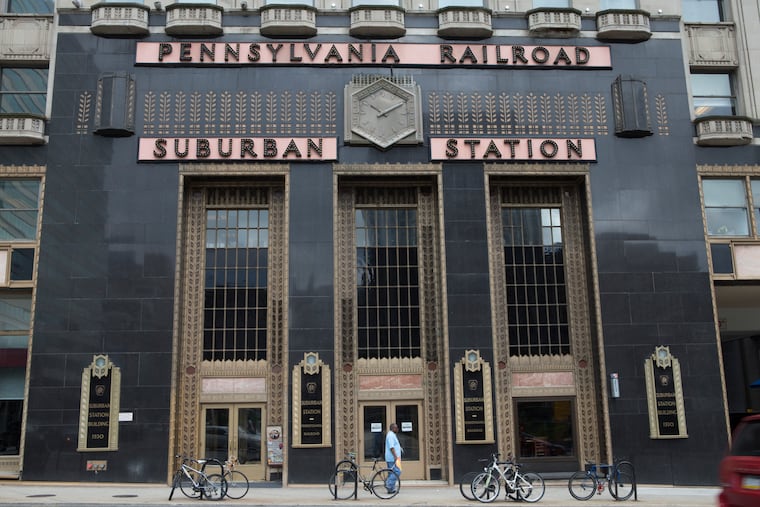Why Philadelphia’s Suburban Station is in the heart of the city
Why a train station in the heart of Philly has "suburban" in its name.

In late September 1930, Lit Brothers was having a sale. Suburban shoppers in search of a deal could catch a train to Broad Street Station, and walk to the store at Eighth and Market streets. Once there, they could buy a 10-piece bedroom furniture set for $59 or a printed dress for $1.87. Across the street, Gimbels was having its 88th anniversary sale. Women could buy “Paris-styled leather handbags” for $2.69 or a 14 karat white gold wrist watch for $24.74.
Lits, Gimbels and the Broad Street Station no longer exist. But a much more permanent addition to Philadelphia was about to be unveiled. On Sept. 28, 1930 the brand new Broad Street Suburban Station opened at 16th Street and Pennsylvania Boulevard — now known as John F. Kennedy Boulevard.
>> READ MORE: Why recycling is now a money loser, not a moneymaker for Philly
Why would a structure in the heart of the city be named Suburban Station? That paradox was raised by several readers through Curious Philly, our question-and-answer forum in which readers submit questions about their communities, and our journalists report out the answers.
In this case the answer is a simple one: The station was the Philadelphia terminus for Pennsylvania Railroad’s “suburban electric trains.” It’s named for where the trains came from, not where they ended up. Towns feeding the station included the stops on the Main Line (named after the railroad’s main line to Harrisburg), and included Bryn Mawr, Haverford, Villanova, Paoli, Malvern and Devon, as well as other stations in surrounding counties.
>> READ MORE: Introducing Curious Philly: Where we help you find answers
This was a precursor to SEPTA’s Regional Rail system, whose hub-and spoke-model has been largely unchanged since the early 20th century. The routes are the same now as they were 100 years ago, with the exception of a commuter rail tunnel under Center City added in 1984.
On today’s map, all SEPTA regional rail lines funnel through 30th Street, Suburban and Jefferson stations, thanks to that rail tunnel.
None of these existed in 1929.
Before Suburban Station, Pennsylvania Railroad trains went to the Broad Street Station, a huge train shed built in 1881 and located in the shadow of City Hall at what is now Penn Plaza. Suburban was designed to handle only the electric trains, while Broad Street could handle steam engines as well.
Reading Railroad trains — carrying passengers from lines that went to Norristown, Doylestown and West Trenton — went to Reading Terminal, another giant train shed that is now part of the Pennsylvania Convention Center.
Once Suburban Station opened in 1930, it became the new, technologically advanced commuter terminal. According to a Sept. 21, 1930 Inquirer article, the station had yellow and green flashing lights to announce trains’ arrivals and departures, and an “acoustic ceiling” to reduce noise.
The 20-story art deco building over the terminal also housed the Pennsylvania Railroad’s corporate headquarters until 1957.
It was only a few more years until 30th Street Station opened, in 1933, and became the Pennsylvania Railroad’s main passenger station for inter-city trains.
By 1952, Broad Street Station was no longer in use and torn down. according to Philly History blog.
In the 1960s, when railroads were in financial trouble, the Pennsylvania and Reading railroads operated their commuter trains under contract to the newly created South Eastern Pennsylvania Transportation Authority. By 1983, SEPTA assumed control of the two railroads’ separate commuter operations.
In 1984, the opening of the $330 million Center City rail tunnel linked the two former railroads’ lines through what is now called Jefferson Station, built under what had been the Reading Terminal.
Since its inception, Suburban Station has served as one of Philly’s central hubs for commuter trains and is continuously improving its amenities.
>> READ MORE: Suburban Station on track for a shopping destination
In October 2017, SEPTA announced plans to add food venues and apparel shops, creating Station Shops at Suburban.
The station is also being used to give back to the Philadelphia community.
>> READ MORE: Get a first look at Suburban Station’s new homeless services center
In January 2018 the Hub of Hope opened in the Suburban concourse as a respite for the city’s homeless population. The hub provides services ranging from showers and laundry to addiction treatment for those in need.